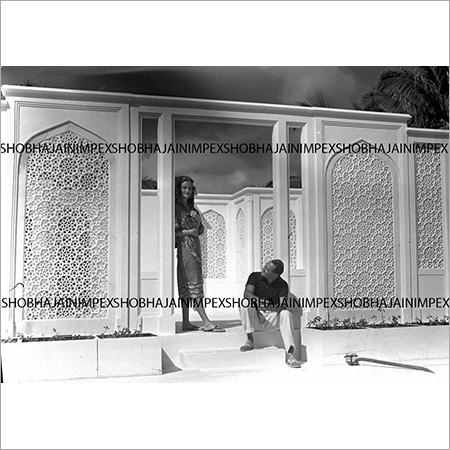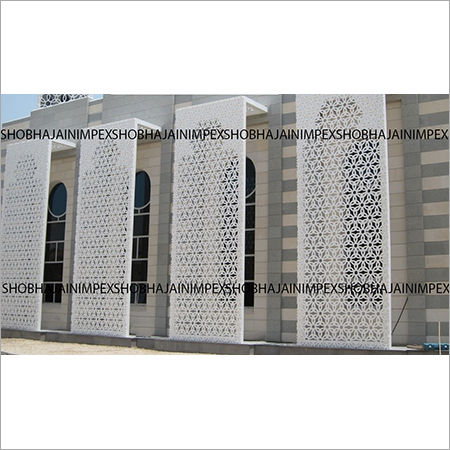Product Description
GRC FRP facades is a critical component that plays an essential role in the preparation of any event, enhancing the aesthetic appeal as well as functionality of venues. These facades are architectural elements that are used to transform spaces for memorable celebrations. Decorative glass reinforced concrete, and fiber reinforced polymer facades act as backdrops for stages and photo booths, seamlessly blending with the event theme and improving the visual appeal. These facades allow for lighting effects that create an ambiance that aligns with the event's color scheme. These portable facades also act as privacy screens, which can also be personalized as required.
GRC, or Glass Reinforced Concrete, is a construction material that combines concrete with glass fiber reinforcement. It is often used in architectural applications, including building facades.
GRC facades offer several advantages:
1. Lightweight: GRC is significantly lighter than traditional concrete, making it easier to handle and install. This is particularly important for facade applications where weight considerations are crucial.
2. Strength: Despite its lightweight nature, GRC is still strong and durable. It can withstand various weather conditions and is resistant to corrosion and fire.
3. Versatility: GRC can be molded into a wide range of shapes and forms. This allows architects and designers to create intricate and complex facade designs that might be difficult or costly to achieve with other materials.
4. Texture and Finish: GRC can mimic the appearance of various materials, such as stone or wood, through the use of molds and surface finishes. This versatility in texture and finish options allows for a wide range of aesthetic possibilities.
5. Weather Resistance: GRC is highly resistant to weathering, UV radiation, and pollution. This makes it an excellent choice for facades that need to maintain their appearance over time.
6. Low Maintenance: GRC facades generally require minimal maintenance. They do not corrode or deteriorate as quickly as some other facade materials.
7. Energy Efficiency: GRC can be used in conjunction with insulation materials to improve a building's energy efficiency, which is essential for sustainable architecture.
8. Cost-Effective: While the initial cost of GRC may be higher than some other materials, its long-term durability and low maintenance requirements can make it a cost-effective choice over the life of a building.
GRC facades are commonly used in modern architectural designs to achieve innovative and eye-catching building exteriors. They offer a blend of aesthetic appeal, functionality, and durability that makes them a popular choice for both new construction and renovation projects.
Uses of GRC Facade:
Glass Reinforced Concrete (GRC) facades have a wide range of uses in architectural design due to their versatility, strength, and aesthetic appeal. Here are some common uses of GRC facades:
1. Commercial Buildings: GRC facades are often used in the construction of commercial buildings such as offices, retail spaces, and shopping malls. They can help create a visually striking and modern appearance that attracts customers and tenants.
2. Residential Buildings: GRC can be employed in the construction of high-end residential buildings, apartment complexes, and luxury homes. It allows for unique and custom facade designs that enhance the overall aesthetic of the building.
3. Cultural and Institutional Buildings: GRC facades can be found on cultural and institutional buildings like museums, libraries, and theaters. Their ability to mimic the appearance of traditional building materials like stone or wood can help these structures blend into their surroundings or convey a specific architectural style.
4. Hotels and Hospitality: Many hotels and resorts use GRC facades to create visually appealing and durable exteriors. The lightweight nature of GRC can make it easier to construct complex architectural features often seen in luxury hotels.
5. Educational Facilities: GRC facades are used in the construction of schools, universities, and research centers. They can be combined with energy-efficient insulation to improve the sustainability and energy performance of educational buildings.
6. Healthcare Facilities: GRC can be employed on the facades of hospitals and medical facilities, offering a clean and modern appearance. Its durability and low maintenance requirements make it a practical choice for healthcare buildings.
7. Mixed-Use Developments: GRC facades are suitable for mixed-use developments that incorporate commercial, residential, and recreational spaces. Their versatility allows for cohesive design themes across various parts of a development.
8. Historic Renovations: GRC can be used in the renovation of historic buildings to replicate original architectural details while providing modern performance characteristics. This helps preserve the historical character of the structure while enhancing its longevity.
9. Exhibition and Event Spaces: GRC is often used in the construction of exhibition centers, convention halls, and event venues due to its ability to create striking and unique facades that can complement the interior spaces.
10. Landmark and Iconic Structures: Some iconic and landmark structures around the world feature GRC facades. These structures often showcase the material's ability to realize ambitious and creative architectural visions.
GRC facades offer architects and designers the freedom to explore innovative and aesthetically pleasing designs while meeting the functional requirements of modern buildings. Their versatility and durability make them a popular choice for a wide range of construction projects.
FAQ:
Q. What is GRC?
Ans: RC stands for Glass Reinforced Concrete. It is a composite material that combines cement, fine aggregates, water, chemical admixtures, and glass fibers to create a strong, lightweight, and durable construction material.
Q. What are GRC facades?
Ans: GRC facades refer to the use of Glass Reinforced Concrete panels or elements on the exterior of buildings. These panels are used for cladding and can be designed in various shapes, sizes, and textures to enhance the aesthetics of a building's exterior.
Q. What are the advantages of using GRC for facades?
Ans: Some advantages of GRC facades include their lightweight nature, strength, versatility in design, weather resistance, low maintenance requirements, and the ability to mimic the appearance of other materials.
Q. What types of finishes are possible with GRC facades?
Ans: GRC facades can be finished to mimic the appearance of various materials, including stone, wood, or metal. They can also be customized with different textures and colors.
Q. Is GRC environmentally friendly?
Ans: GRC can be considered environmentally friendly if produced using sustainable practices and if it helps improve a building's energy efficiency. It is generally a durable material, which can reduce the need for replacements and maintenance.
Q. How long do GRC facades last?
Ans: The lifespan of GRC facades depends on factors like the quality of materials, installation, and maintenance. When properly installed and maintained, GRC facades can last for several decades.
Q. Is GRC suitable for all climates?
Ans: Yes, GRC is suitable for a wide range of climates. It is highly resistant to weathering, UV radiation, and pollution, making it suitable for both hot and cold climates.
Q. Can GRC facades be used in historical renovations?
Ans: Yes, GRC facades are often used in historical renovations to replicate original architectural details while providing modern performance characteristics.
Q. What is the cost of GRC facades compared to other materials?
Ans: The cost of GRC facades can vary depending on factors like design complexity, finish, and the region where the project is located. While the initial cost may be higher than some materials, the long-term durability and low maintenance requirements can make it cost-effective.
Q. Are there any maintenance requirements for GRC facades?
Ans: GRC facades generally require minimal maintenance. Regular cleaning to remove dirt and pollutants is usually sufficient to keep them looking good. Sealing the surface may also be recommended in some cases.
Q. Can GRC facades be used for interior applications?
Ans: While GRC is primarily used for exteriors, it can also be employed for interior applications such as wall cladding, ceilings, and decorative elements.







 English
English Spanish
Spanish French
French German
German Italian
Italian Chinese (Simplified)
Chinese (Simplified) Japanese
Japanese Korean
Korean Arabic
Arabic Portuguese
Portuguese





